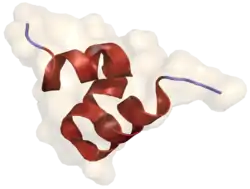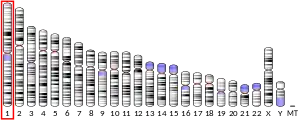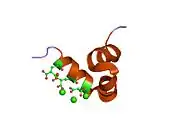Osteocalcin
Osteocalcin, also known as bone gamma-carboxyglutamic acid-containing protein (BGLAP), is a small (49-amino-acid[5]) noncollagenous protein hormone found in bone and dentin, first identified as a calcium-binding protein in chick bone.[6]
Because osteocalcin has gla domains, its synthesis is vitamin K dependent. In humans, osteocalcin is encoded by the BGLAP gene.[7][8] Its receptors include GPRC6A, GPR158, and possibly a third, yet-to-be-identified receptor.[9][10]
Function
Osteocalcin is secreted solely by osteoblasts and thought to play a role in the body's metabolic regulation.[11] In its carboxylated form it binds calcium directly and thus concentrates in bone.
In its uncarboxylated form, osteocalcin acts as a hormone in the body, signalling in the pancreas, fat, muscle, testes, and brain.[12]
- In the pancreas, osteocalcin acts on beta cells, causing beta cells in the pancreas to release more insulin.[11]
- In fat cells, osteocalcin triggers the release of the hormone adiponectin, which increases sensitivity to insulin.[11]
- In muscle, osteocalcin acts on myocytes to promote energy availability and utilization and in this manner favors exercise capacity.[13]
- In the testes, osteocalcin acts on Leydig cells, stimulating testosterone biosynthesis and therefore affects male fertility.[14]
- In the brain, osteocalcin plays an important role in development and functioning.[15]
An acute stress response, colloquially known as the fight-or-flight response, stimulates osteocalcin release from bone within minutes in mice, rats, and humans. Injections of high levels of osteocalcin alone can trigger an ASR in the presence of adrenal insufficiency.[16]
Use as a biochemical marker for bone formation
As osteocalcin is produced by osteoblasts, it is often used as a marker for the bone formation process. It has been observed that higher serum osteocalcin levels are relatively well correlated with increases in bone mineral density during treatment with anabolic bone formation drugs for osteoporosis, such as teriparatide. In many studies, osteocalcin is used as a preliminary biomarker on the effectiveness of a given drug on bone formation. For instance, one study which aimed to study the effectiveness of a glycoprotein called lactoferrin on bone formation used osteocalcin as a measure of osteoblast activity.[17]
References
- GRCh38: Ensembl release 89: ENSG00000242252 - Ensembl, May 2017
- GRCm38: Ensembl release 89: ENSMUSG00000074489 - Ensembl, May 2017
- "Human PubMed Reference:". National Center for Biotechnology Information, U.S. National Library of Medicine.
- "Mouse PubMed Reference:". National Center for Biotechnology Information, U.S. National Library of Medicine.
- Hauschka, P. V.; Carr, S. A.; Biemann, K. (1982). "Primary structure of monkey osteocalcin". Biochemistry. 21 (4): 638–42. doi:10.1021/bi00533a006. PMID 6978733.
- Hauschka PV, Reid ML (August 1978). "Timed appearance of a calcium-binding protein containing gamma-carboxyglutamic acid in developing chick bone". Developmental Biology. 65 (2): 426–34. doi:10.1016/0012-1606(78)90038-6. PMID 680371.
- Puchacz E, Lian JB, Stein GS, Wozney J, Huebner K, Croce C (May 1989). "Chromosomal localization of the human osteocalcin gene". Endocrinology. 124 (5): 2648–50. doi:10.1210/endo-124-5-2648. PMID 2785029.
- Cancela L, Hsieh CL, Francke U, Price PA (September 1990). "Molecular structure, chromosome assignment, and promoter organization of the human matrix Gla protein gene". The Journal of Biological Chemistry. 265 (25): 15040–8. PMID 2394711.
- Pi M, Wu Y, Quarles LD (July 2011). "GPRC6A mediates responses to osteocalcin in β-cells in vitro and pancreas in vivo". Journal of Bone and Mineral Research. 26 (7): 1680–3. doi:10.1002/jbmr.390. PMC 5079536. PMID 21425331.
- Berger JM, Singh P, Khrimian L, Morgan DA, Chowdhury S, Arteaga-Solis E, et al. (September 2019). "Mediation of the Acute Stress Response by the Skeleton". Cell Metabolism. 30 (5): 890–902.e8. doi:10.1016/j.cmet.2019.08.012. PMC 6834912. PMID 31523009.
- Lee NK, Sowa H, Hinoi E, Ferron M, Ahn JD, Confavreux C, et al. (August 2007). "Endocrine regulation of energy metabolism by the skeleton". Cell. 130 (3): 456–69. doi:10.1016/j.cell.2007.05.047. PMC 2013746. PMID 17693256.
- Karsenty G, Olson EN (March 2016). "Bone and Muscle Endocrine Functions: Unexpected Paradigms of Inter-organ Communication". Cell. 164 (6): 1248–1256. doi:10.1016/j.cell.2016.02.043. PMC 4797632. PMID 26967290.
- Mera P, Laue K, Ferron M, Confavreux C, Wei J, Galán-Díez M, et al. (June 2016). "Osteocalcin Signaling in Myofibers Is Necessary and Sufficient for Optimum Adaptation to Exercise". Cell Metabolism. 23 (6): 1078–1092. doi:10.1016/j.cmet.2016.05.004. PMC 4910629. PMID 27304508.
- Karsenty G, Oury F (January 2014). "Regulation of male fertility by the bone-derived hormone osteocalcin". Molecular and Cellular Endocrinology. 382 (1): 521–526. doi:10.1016/j.mce.2013.10.008. PMC 3850748. PMID 24145129.
- Obri A, Khrimian L, Karsenty G, Oury F (March 2018). "Osteocalcin in the brain: from embryonic development to age-related decline in cognition". Nature Reviews. Endocrinology. 14 (3): 174–182. doi:10.1038/nrendo.2017.181. PMC 5958904. PMID 29376523.
- Meyer-Berger J, Singh P, Khrimian L, Morgan D, Chowdhury S, Arteaga-Solis E, Horvath T, Domingos A, Marsland A, Yadav V, Rahmouni K, Gao X, Karsenty G (2019). "Mediation of the Acute Stress Response by the Skeleton". Cell Metabolism. 30 (5): 890–902.e8. doi:10.1016/j.cmet.2019.08.012. PMC 6834912. PMID 31523009.
- Bharadwaj S, Naidu AG, Betageri GV, Prasadarao NV, Naidu AS (September 2009). "Milk ribonuclease-enriched lactoferrin induces positive effects on bone turnover markers in postmenopausal women". Osteoporosis International. 20 (9): 1603–11. doi:10.1007/s00198-009-0839-8. PMID 19172341.
Further reading
- Kamdem LK, Hamilton L, Cheng C, Liu W, Yang W, Johnson JA, et al. (June 2008). "Genetic predictors of glucocorticoid-induced hypertension in children with acute lymphoblastic leukemia". Pharmacogenetics and Genomics. 18 (6): 507–14. doi:10.1097/FPC.0b013e3282fc5801. PMID 18496130.
- Lin GT, Tseng HF, Chang CK, Chuang LY, Liu CS, Yang CH, et al. (February 2008). "SNP combinations in chromosome-wide genes are associated with bone mineral density in Taiwanese women". The Chinese Journal of Physiology. 51 (1): 32–41. PMID 18551993.
- Lumachi F, Camozzi V, Tombolan V, Luisetto G (September 2009). "Bone mineral density, osteocalcin, and bone-specific alkaline phosphatase in patients with insulin-dependent diabetes mellitus". Annals of the New York Academy of Sciences. 1173 Suppl 1: E64-7. doi:10.1111/j.1749-6632.2009.04955.x. PMID 19751417.
- Kanazawa I, Yamaguchi T, Yamamoto M, Yamauchi M, Yano S, Sugimoto T (September 2009). "Serum osteocalcin/bone-specific alkaline phosphatase ratio is a predictor for the presence of vertebral fractures in men with type 2 diabetes". Calcified Tissue International. 85 (3): 228–34. doi:10.1007/s00223-009-9272-4. PMID 19641839.
- Makita N, Suzuki M, Asami S, Takahata R, Kohzaki D, Kobayashi S, et al. (April 2008). "Two of four alternatively spliced isoforms of RUNX2 control osteocalcin gene expression in human osteoblast cells". Gene. 413 (1–2): 8–17. doi:10.1016/j.gene.2007.12.025. PMID 18321663.
- Desbois C, Karsenty G (March 1995). "Osteocalcin cluster: implications for functional studies". Journal of Cellular Biochemistry. 57 (3): 379–83. doi:10.1002/jcb.240570302. PMID 7768973.
- Salem AM, Zohny SF, Abd El-Wahab MM, Hamdy R (November 2007). "Predictive value of osteocalcin and beta-CrossLaps in metastatic breast cancer". Clinical Biochemistry. 40 (16–17): 1201–8. doi:10.1016/j.clinbiochem.2007.07.006. PMID 17889845.
- Im JA, Yu BP, Jeon JY, Kim SH (October 2008). "Relationship between osteocalcin and glucose metabolism in postmenopausal women". Clinica Chimica Acta; International Journal of Clinical Chemistry. 396 (1–2): 66–9. doi:10.1016/j.cca.2008.07.001. PMID 18657532.
- Ba Y, Huang H, Yang Y, Cui L, Zhu J, Zhu C, et al. (November 2009). "The association between osteocalcin gene polymorphism and dental fluorosis among children exposed to fluoride in People's Republic of China". Ecotoxicology and Environmental Safety. 72 (8): 2158–61. doi:10.1016/j.ecoenv.2009.08.014. PMID 19767102.
- Hwang YC, Jeong IK, Ahn KJ, Chung HY (November 2009). "The uncarboxylated form of osteocalcin is associated with improved glucose tolerance and enhanced beta-cell function in middle-aged male subjects". Diabetes/Metabolism Research and Reviews. 25 (8): 768–72. doi:10.1002/dmrr.1045. PMID 19877133.
- Yerges LM, Klei L, Cauley JA, Roeder K, Kammerer CM, Moffett SP, et al. (December 2009). "High-density association study of 383 candidate genes for volumetric BMD at the femoral neck and lumbar spine among older men". Journal of Bone and Mineral Research. 24 (12): 2039–49. doi:10.1359/jbmr.090524. PMC 2791518. PMID 19453261.
- Yu S, Jiang Y, Galson DL, Luo M, Lai Y, Lu Y, et al. (February 2008). "General transcription factor IIA-gamma increases osteoblast-specific osteocalcin gene expression via activating transcription factor 4 and runt-related transcription factor 2". The Journal of Biological Chemistry. 283 (9): 5542–53. doi:10.1074/jbc.M705653200. PMC 2736298. PMID 18171674.
- Kayed H, Bekasi S, Keleg S, Michalski CW, Giese T, Friess H, Kleeff J (December 2007). "BGLAP is expressed in pancreatic cancer cells and increases their growth and invasion". Molecular Cancer. 6: 83. doi:10.1186/1476-4598-6-83. PMC 2245975. PMID 18163903.
- French D, Hamilton LH, Mattano LA, Sather HN, Devidas M, Nachman JB, Relling MV (May 2008). "A PAI-1 (SERPINE1) polymorphism predicts osteonecrosis in children with acute lymphoblastic leukemia: a report from the Children's Oncology Group". Blood. 111 (9): 4496–9. doi:10.1182/blood-2007-11-123885. PMC 2343589. PMID 18285546.
- Pittas AG, Harris SS, Eliades M, Stark P, Dawson-Hughes B (March 2009). "Association between serum osteocalcin and markers of metabolic phenotype". The Journal of Clinical Endocrinology and Metabolism. 94 (3): 827–32. doi:10.1210/jc.2008-1422. PMC 2681283. PMID 19088165.
- Kindblom JM, Ohlsson C, Ljunggren O, Karlsson MK, Tivesten A, Smith U, Mellström D (May 2009). "Plasma osteocalcin is inversely related to fat mass and plasma glucose in elderly Swedish men". Journal of Bone and Mineral Research. 24 (5): 785–91. doi:10.1359/jbmr.081234. PMID 19063687.
- Wahlgren CM, Zheng W, Shaalan W, Tang J, Bassiouny HS (2009). "Human carotid plaque calcification and vulnerability. Relationship between degree of plaque calcification, fibrous cap inflammatory gene expression and symptomatology". Cerebrovascular Diseases. 27 (2): 193–200. doi:10.1159/000189204. PMID 19136823.
- Lumachi F, Ermani M, Camozzi V, Tombolan V, Luisetto G (September 2009). "Changes of bone formation markers osteocalcin and bone-specific alkaline phosphatase in postmenopausal women with osteoporosis". Annals of the New York Academy of Sciences. 1173 Suppl 1: E60-3. doi:10.1111/j.1749-6632.2009.04953.x. PMID 19751416.
- Born AK, Rottmar M, Lischer S, Pleskova M, Bruinink A, Maniura-Weber K (October 2009). "Correlating cell architecture with osteogenesis: first steps towards live single cell monitoring". European Cells & Materials. 18: 49–60, 61–2, discussion 60. PMID 19856264.
- Fujisawa R (March 2002). "[Recent advances in research on bone matrix proteins]". Nihon Rinsho. Japanese Journal of Clinical Medicine. 60 Suppl 3: 72–8. PMID 11979972.
External links
- Osteocalcin at the US National Library of Medicine Medical Subject Headings (MeSH)
- Overview of all the structural information available in the PDB for UniProt: Q8HYY9 (Pig Osteocalcin) at the PDBe-KB.






